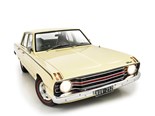Chrysler Valiant VF + VG Pacer Review

































































|

|

|

|

|

|

|

|

|

|

|

|

|

|

|

|

|

|

|

|

|

|

|

|

|

|

|

|

|

|

|

|
Half a century on we're still impressed by the thinking that produced the Pacer - Chrysler's wild child for 1969
Nineteen sixty-nine was the year of Abbey Road, flower power and the Valiant Pacer. Despite its 225-cubic inch engine and its unmistakably VF Valiant bodyshell, this Aussie Mopar was a far cry from anything the company had offered before.
It’s probably fair to say that the original Pacer caught the market by surprise. In March 1969 there was simply nothing else like it. Even though small-block V8 engines were available widely across the local Big Three (Holden, Falcon, Valiant), with Chrysler Australia having been first with the up-spec Valiant V8 sedan in 1965, the marketing dudes at Tonsley Park decided that the Pacer should use a mildly hot-rodded slant six.
.jpg)
Chrysler Australia had never bothered chasing any kind of youth market until the invention of the Pacer. Somewhere, there must have been a light bulb moment because the Pacer was as carefully aimed at younger buyers as the V8 sedans and VIPs before it had been aimed at the middle-aged. It came to market at a staggering $2798 and no other car in the price range could match the car’s 17.8 standing 400-metre time or 174km/h (108mph) top speed. No official maximum power figure was ever released but 130kW (175 bhp) is about the number.
| 2019 Market Review: 1966-71 Chrysler Valiant/Regal/VIP
.jpg) 'Wild red' paint, fat tyres, purposeful stance. All good
'Wild red' paint, fat tyres, purposeful stance. All good
To insert myself briefly into this context, at the time of the Pacer’s debut I drove a Mosman Blue FJ Special. I had ‘improved’ its specification by removing the bonnet emblem and the hubcaps and getting a Speco-Thomas three-speed floorshift conversion. If I’d had some money I would have got the cylinder head ported and polished and maybe fitted twin carbies. A tachometer mounted as an afterthought somewhere on the dashboard would have been wonderful. It was lowered in the rear. Now I’m not saying this was precisely the approach taken by Chrysler Australia but there were some similarities. The standard three-on-the-floor gearshift (blessedly, an automatic transmission wasn’t even optional) was straight out of the street machiner’s manual, even if the term was yet to come into usage. But it was so basically executed that there was no lockout on reverse (unlike its R- and S-Series predecessors). In reviving a 1930s trend – and anticipating the 1990s and early 2000s – the stylists gave the Pacer white-faced instruments with black lettering. The high-backed bucket seats were about the only remotely plush aspect of the Pacer’s décor.
| Buyer's Guide: Chrysler Valiant VG Pacer
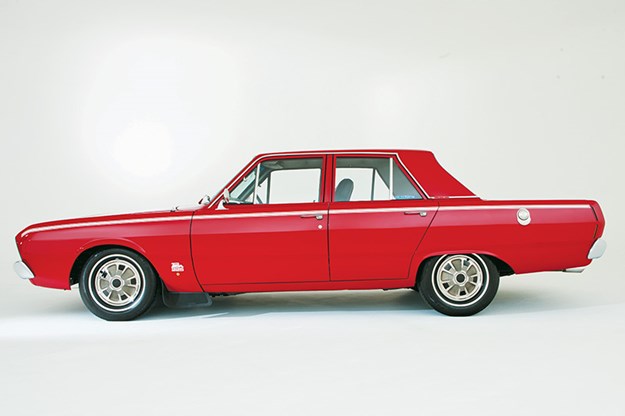
These seats (‘aircraft-type with built-in headrests’, according to the marketing department), which were quickly dubbed ‘tombstone’ by the motoring press, represented an important safety initiative. So, too, did the availability of front disc brakes at the very reasonable price of $55. The fact they weren’t standard shows how keen the execs were on keeping the price below $2800. At least the standard front drums were finned for better heat dissipation, following the precedent set by the original Valiant V8 sedan in 1965 (When I went into a Chrysler dealership to inspect the Pacer – fittingly in Wild Yellow, the salesman said he wouldn’t sell me one unless I ordered the disc brakes but, sadly, I was only dreamin!).
To extract more power and much more torque from the venerable slant six, the engineers had raised the compression ratio from 8.4:1 to 9.2:1 and fitted a dual-throat carburettor, as well as designing a better exhaust.
| Read more: Chrysler Valiant VG Regal 770 review
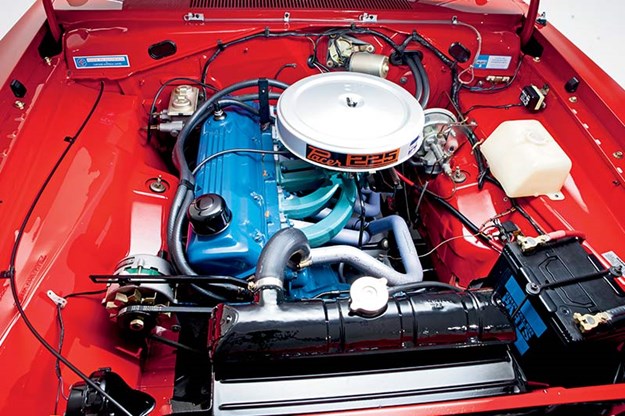
And the colour palette was clearly aimed at younger buyers with just three choices, all bearing the adjective ‘Wild’: Yellow, Blue, Red. The grille got red-painted highlights. There was a red rear moulding. Narrow waist-high body striping and bold Pacer 225 decals reinforced the sports story. No, the hubcaps weren’t removed but they were changed for sportier looking faux mag wheel items. The front torsion bars and rear leaf springs were lowered half an inch. A heavy-duty front anti-roll bar was fitted. And how about ‘fat, high-speed tyres on wide 51/2 inch rims’?
The Pacer was seen as quite the boy racer’s special. In many respects it was the affordable (at least for some) alternative to a Falcon GT. And, remember, it was on sale some months before the first of the Super Roo models with their brazen emblazonings. Full-page magazine advertisements were headed: ‘Fat tyres, floor shift, $2798’.
| Buyer's Guide: Valiant VF Pacer
 Cheap 'n' cheerful trim works just fine
Cheap 'n' cheerful trim works just fine
Its closest rival was perhaps the Monaro GTS in standard 186S guise. This was priced at $3090 but was better equipped. It was also painfully slower, requiring 19 whole seconds for the standing quarter mile (400m). While the GTS had an extra gear ratio, the Opel box was supposed to be fragile. When I owned one, my mechanic advised me not to drive the car hard in first or second, so not a car for Mount Panorama, then! But the Valiant three-speed gearbox was as rugged as the Pacer itself.
The Fiat 125 cost a little more than the Pacer but could not match its performance. But it could do the quarter mile in 18.2 and reach 160km/h. Perhaps its biggest claim to performance fame was its powerful set of four-wheel disc brakes which came in handy at the end of Conrod Straight.
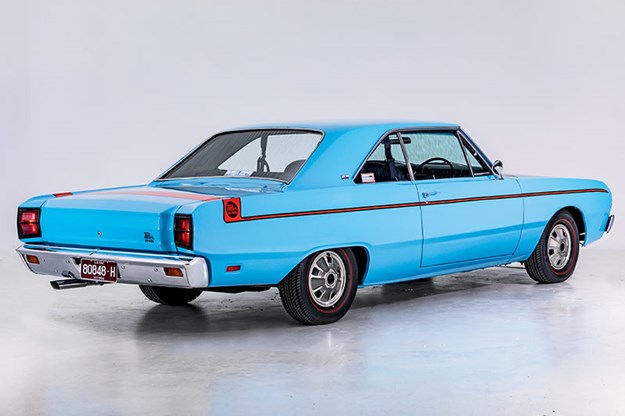
Later in the year came the Renault 16TS, another four-cylinder quasi-GT. And Mazda had its rotary-engined R100. It almost goes without saying that back in the days when the Bathurst 500-mile race really was a showroom shootout, all these models got a run. Of the four, the Pacer with optional discs was the quickest around Mount Panorama.
| Meet the owner: Tim Bond's Valiant VG Pacer

Only one car was entered in the 1969 race, with the driver pairing of (motoring journo) Mike Kable and Graham Ryan. The established champion car in Class C over the past four years was still the Cooper S. For 1969 the classes were still done by price and Class C was for cars priced from $2251 to $3000.There were nine Minis, the Pacer, three R100s, two Capri 1600GTs, three Fiat 125s and a Renault 16TS.

I haven’t been able to find qualifying times but the order on the grid for the start of the 1969 Hardie-Ferodo 500 was: grid position 27 Cooper S (Cameron/Prisk), 29 Cooper S (Mander/Evans), 30 Pacer, 31 R100 (Haehnle/Wherrett), 32 R100 (Mason/Mason), 33 Cooper S (Hindmarsh/Stanley), 34 Fiat 125 (Forbes/Finlay), 35 R100 (Cooke/Spence), 36 Cooper S (Gracie/Gillard), 37 Fiat 125 (Kearns/Lister), 38 Capri (Grose/Wright), 39 Cooper S (Meehan/Brewster), 40 Fiat 125 (Cole/Keefe), 42 Cooper S (Frazer/Johns), 45 Cooper S (Grose/Moore), 47 Cooper S (Thomson/Corness), 48 Capri (Cant/Cook) and 53 Renault 16TS. Significantly, the fastest of the Class B ($1861 to $2250) cars, namely six Datsun 1600s (fastest was Stewart/Garth on grid 41) and the Hillman Gazelle of Ledingham/Beck made inroads into the Class C cars while the 16TS was one spot behind the fastest Corolla (Sampson/Morris) and a long way back from the Pacer, Mazda and Fiats.
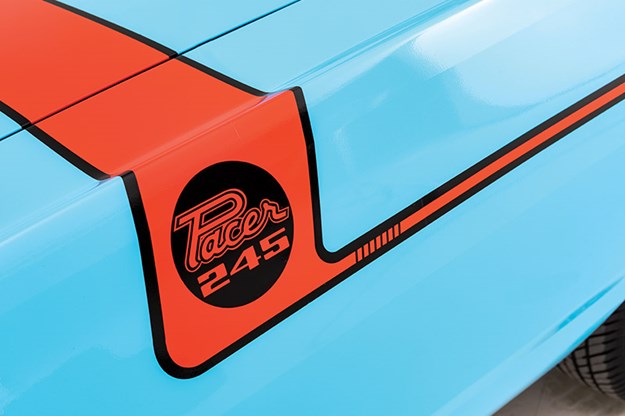
Here’s some lap time relativity. The Geoghegan brothers’ Falcon took pole on 2:48.9 and the Sampson/Morris Corolla qualified in 3:27.1. Looking at the 1968 times, where the fastest Fiat 125 (Muir/Cooke) managed 3:18.9, it's likely that the Pacer was down to something like 3:10. Not bad for $2798! That was the year of Bill Brown’s first terrible crash (on lap one at Skyline). The Pacer, heavy on brakes and tyres, finished a creditable fourth in class, completing 118 laps, one fewer than the class-winning Warren Gracie/Ron Gillard Cooper S and 12 behind the outright winner, the Colin Bond/Tony Roberts Holden Monaro GTS350.
This Mount Panorama history highlights the fact that the VF Pacer was Chrysler's first step toward producing a hot Valiant. Its success in the market doubtless reinforced Chrysler Australia’s marketing executives’ determination to build its performance models around a six-cylinder engine.
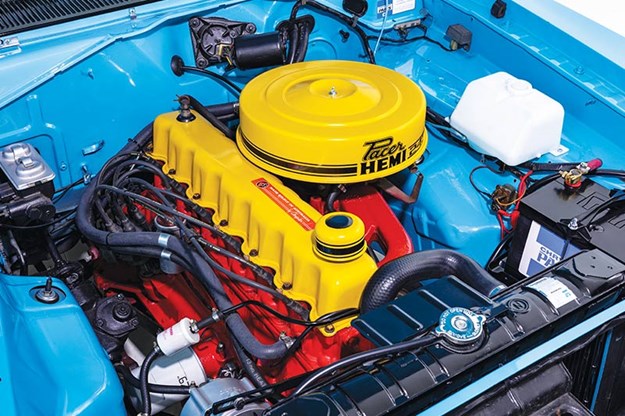 It sits up straight. It's called the Hemi six. And its got tunza grunt
It sits up straight. It's called the Hemi six. And its got tunza grunt
Just a year later the VG Pacer was almost a model range in its own right. The Hemi 6 replaced the old engine and even the basic Valiant had 123kW. The Pacer entered the market with a dual-barrel carburettor and 138kW. Then came the 'E' options: E31 added a hotter cam, a smaller cooling fan and a type of baffled sump. E34 was called ‘Track Pack’ and included goodies like shot-penned crankshaft and conrods and a larger radiator. Output was 175kW. E35 was the Street Pack. The E34 and E35 are commonly known as the ‘four-barrel’ Hemi Pacer. The VG also offered a two-door hardtop body in the Pacer range. If anything, this VG variety serves to accentuate the singularity of its VF predecessor. Front disc brakes or not, then choose your colour, namely yellow, blue or red. There has probably never been quite such an interesting marketing exercise in local automotive industry history, although the later Belmont-based HQ SS came close and followed essentially the same principle.
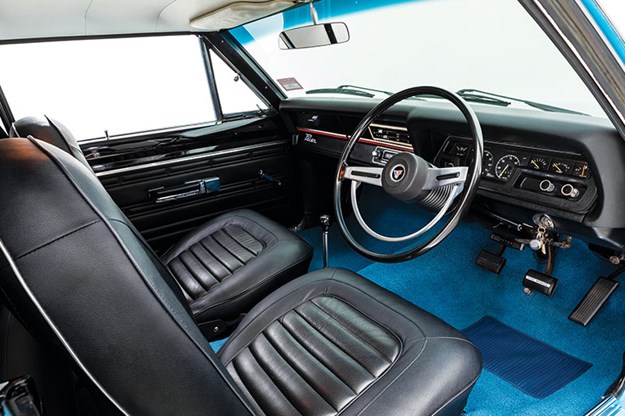 While all-black trim was popular in the day, the colour-keyed carpet provides a pleasing contrast in this lovely VG
While all-black trim was popular in the day, the colour-keyed carpet provides a pleasing contrast in this lovely VG
But the HQ SS was a 1972 limited edition special, testing the market for the possibility of a range of four-door GTS Monaros, while the VF Pacer was a stand-alone offering within the VF Range and available for the duration of that model. Rorty, sporty and cheap, it was an outstandingly good effort at a first sporty interpretation of the essentially stolid Valiant. When compared with Ford and Holden rivals, the Pacer made the most sense in terms of bang for your bucks, especially at $2853 with optional front discs. While the Falcon GT had Fairmont-level trim and the GTS Monaro equated to at least a Premier, the Pacer unashamedly grabbed its trimmings from the bargain basement. A fullhouse Monaro approached four grand as did the Falcon GT and no other sub-$3000 road rocket could run a 17.8 quarter, then double as a family hack with room for five hefty Aussies and their gear.
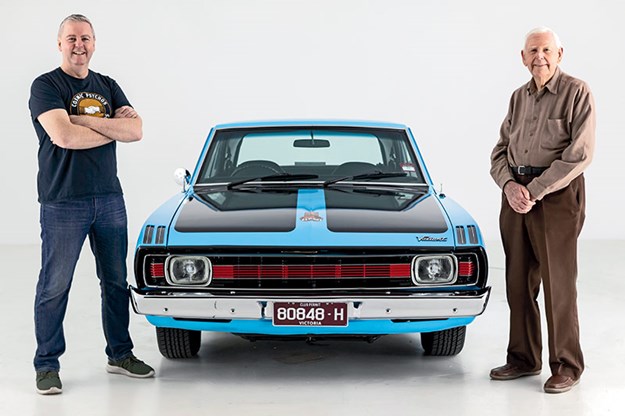 Tim Bond and his dad Leo – Valiants are a family thing
Tim Bond and his dad Leo – Valiants are a family thing
1970 Valiant VG Pacer owner - Tim Bond
This car will be the last Pacer I own. Over the years I've had about 20 Valiants, with five Pacers among them. This one came up late at night two years ago and I was there the next morning. He’d had it 18 years and, in his words, had bought it off "a drunken stoned dude up in the Dandenongs".
It's been a two-year journey to get it to this stage and there are still a few things I want to do. I'm a member of the Chrysler Restorers Club and a lot of people there have been tremendously helpful. See more on the story behind this car here.

1970-71 VG Valiant Pacer
NUMBER BUILT 1162
BODY Unitary 4-door sedan or 2-door hardtop
ENGINE 3993cc inline OHV six-cylinder
POWER & TORQUE 138kW @ 5000rpm, 325Nm @ 2000rpm
PERFORMANCE 0-96km/h 8.8s, 0-400 metres: 16.7s
TRANSMISSION 3-speed manual or automatic
SUSPENSION Front: Ind. – with torsion bars, tele. shocks Rear: live axle – with semi-elliptics, tele. shocks
BRAKES disc/drum
TYRES 735 x 14 cross-ply or 185H14 radial
PRICE RANGE $7500-45,000
CONTACT
www.valiantpacers.com
1969-70 VF Valiant Pacer
NUMBER MADE: 4500 (est)
BODY STYLES: steel integrated body/chassis four door sedan
ENGINE: 3687cc inline six-cylinder OHV
POWER & TORQUE: 130kW @ 4500rpm, 310Nm
@ 2700rpm (approx)
PERFORMANCE: 0-96km/h
10.5 seconds, 0-400 metres
17.8 seconds
TRANSMISSION:
Three-speed manual
SUSPENSION: Front: Ind. – with torsion bars, control arms, tele. shocks and anti-roll bar
Rear: Live axle – with semi-elliptic springs and tele. shocks
BRAKES: drum (disc opt) (f) drum (r) power assisted
TYRES: 6.95 x 14 cross-ply
Classic Australian Family Car Value Guide home page
Muscle Car Value Guide home page
Japanese Classic Car Value Guide home page
Unique Cars magazine Value Guides
Sell your car for free right here
Get your monthly fix of news, reviews and stories on the greatest cars and minds in the automotive world.
Subscribe

.jpg)



.jpg)






